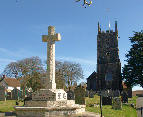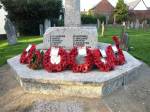Albert Ernest Stapleton was the second son of Alfred Stapleton, a farm labourer, and Elizabeth Cockram, who had previously been married to Robert Alford. In the 1901 census, Albert now aged 8 was living in Church Hill, Winkleigh with his parents now aged 34 and 41 respectively, and the rest of the family. The other children were William Cockram aged 16, Elizabeth’s first child, Ethel Alford age 13, a daughter from Elizabeth’s first marriage, Alfred aged 11, Charles aged 4 and Florence aged 2. According to military records, Albert had been born in Okehampton, athough other records list him and all his siblings as having been born in Winkleigh. By 1911 Albert, now aged 18 and a household servant described as ‘boots’, was living at Pound House, Winkleigh, as a boarder in the home of Richard Mitchell, an insurance agent, with Richard’s wife Ethel and their baby son.
The Territorial Army, created as a result of the Haldane reforms in 1906, had envisaged a force of 300,000 men in fourteen large infantry divisions including field artillery and ancillary services with the Yeomanry Regiments would provide a matching 14 cavalry brigades. The Territorials were designed to be the main force in home defence - to repel enemy coastal raids and deter the threat of a possible invasion. Service overseas was to be strictly on a voluntary basis. The Territorial Force came into existence on 1st April 1908, and was initially very successful in attracting recruits, responding both to the national mood regarding German expansion of their fleet following the launching of British super-battleships, the ‘Dreadnoughts’ and the fact that the annual camp provided young men with 15 days paid holiday which their employers were constrained to permit, though there were many complaints about this in many areas of employment. On the outbreak of war on 4th August, the 1/6th Battalion of the Devonshire Territorials, part of the Devon and Cornwall Infantry Brigade, was one of the four battalions already in camp for their annual two weeks training programme at Woodbury Common near Exmouth. The 1/6th was commanded by Lt. Col. N.R. Radcliffe with 21 other officers and about 700 other ranks, and like most Territorial battalions was well under strength. Recruits for the 1/6th however began to flood in, and Albert Stapleton was among them, enlisting in Winkleigh rather than at the headquarters of the 6th Devons in Barnstaple. The 6th Devons might well have had a recruiting drive in the village. His name is mentioned in the September issue of the Chumleigh Deanery Magazine as being one of the first to serve from Winkleigh, among the 20 men enlisting immediately in the 6th Devons. So great was the rush to join this Territorial battalion that it was immediately named 1st/6th, so that a second duplicate battalion, the 2nd/6th could be raised. Although in the opening weeks of the war the Territorial Army was still considered to be a Home Defence force, many men were coming forward in the hope of going overseas.
Meanwhile, those already serving in the battalion immediately left Woodbury and proceeded not to Barnstaple but to Plymouth where they shared a congested night with the 1/5th Battalion in their Drill Hall, without any facilities for bedding, feeding, cooking or washing. On August 5th the 1/6th moved on to Fort Renny, near Plymouth, mounting guard at various points in case of an immediate German invasion - much feared at the time. On 9th August the 4th, 5th and 6th Battalions all entrained to move to Salisbury Plain, and it is possible that Albert Stapleton joined the 6th Battalion at this stage. The 6th had an unfortunate journey, which started with a 10 mile march to Plymouth station. The train then took them to Salisbury station where, in order to provide some sort of breakfast, the CO had commandeered the entire supplies of the refreshment room. The march to camp was a further 17 miles, with each man carrying rifle, pack and 100 rounds of ammunition. Only half the men completed the journey, and the C.O. was reduced to commandeering, and having to pay for local motor transport to pick up all the stragglers.
The 6th Battalion was attached as ‘Army Troops’ to the Wessex Division when very soon the Division as a whole received orders to proceed direct to India to set fee for field service in France some of the regular battalions serving there before the war. The 6th Battalion received a special message from the King which included the encouragement that the Battalion was ‘helping him and the kingdom as much as if they had gone straight to the front’. Although the Territorials had repeatedly been told before the war that they were merely being asked to form a force for Home Defence it was quickly recognized by Lord Kitchener that they would be needed for much wider service, partially trained though they were. However, overseas service remained voluntary and in order to preserve the Territorial forces (rather than decimate them by transferring the volunteers to New Army battalions) the conditions of service were quickly altered - much to the hostility of many parents who were violently opposed to the idea of their sons serving overseas in a war area. The young men themselves, however, were mostly keen to join the great adventure, and in the three Territorial Battalions of the Devons most men immediately volunteered. By August 31st those in the 6th Devons who had failed their stricter overseas medical examination, together with those who wished to remain as Home Service men, were returned to Barnstaple to serve as a nucleus for a second-line Territorial battalion that was being raised. For those who had volunteered and who remained in camp, hopes of going to France were dashed on 16th September when the 6th received its orders to proceed to India. The Battalion sailed on 9th October landing at Karachi on 11th November.
Although we do not know whether Albert had volunteered for Foreign Service, he certainly decided that he wanted to be married as soon as possible. A quick decision could have been made, either during his embarkation leave, or having declined Foreign Service, following his return to Barnstaple on 31st August. A ten day leave just before embarking on the 7th or 8th October would have just made it possible for the Register Office marriage that took place on 30th September at the Register Office in Exeter, between Albert Stapleton and Elizabeth Ford, a cousin of Albert, then aged 18 and staying in Tudor Street, Exeter. The alternative possibility is that three weeks or so after reaching Barnstaple, Albert obtained leave and was married during that time. Elizabeth was the daughter of George Ford of Winkleigh, who in 1901, when little Elizabeth was aged 6, was working as a labourer at Tuckers, Hollocombe. The Stapletons and the Fords were already connected. George Ford had married Emma Stapleton who had been born in Winkleigh in 1872, and who was Albert Stapleton’s aunt.
There are many instances during the war of young men about to depart for overseas being married, both to experience (in many cases for the first time) married love, and also to ensure that if they were killed or wounded their sweetheart would receive a pension. There is also the very understandable desire of a young man to secure his loved one in order to make sure she was there waiting for him on his return. Tragically, within a few days Albert’s leave was over, and with it his married life, because almost immediately following or even during his leave he contracted enteric fever (also known as typhoid fever). Today, of course, the disease is counteracted with antibiotics and if treated early can be swiftly cured, but in 1914 no such treatments existed in Devon. The disease takes about three weeks or slightly more to run its course before death. Albert died on 31st October, and it is likely therefore he contracted it on or around 7th October, about a week after the wedding. If he was indeed going to India he would have been withdrawn from the draft at once. If he was back in Barnstaple he would possibly have been sent to hospital, so the likelihood is that the first signs of illness appeared while he was home, and that is where he remained.
Peritonitis was added to enteric fever on his death certificate, on which Albert is described as a general labourer, serving in the 6th Battalion of the Devons, the certificate signed by the Winkleigh doctor, Dr. Clements. Enteric fever is often described as typhoid fever, a disease that can only spread in environments where human feces or urine are able to come into contact with food or drinking water, and where careful food preparation and washing of hands are therefore crucial. Sanitation and hygiene are the critical measures that can be taken to prevent typhoid fever, which can only be transmitted from human to human. It is perhaps too easy to draw the obvious conclusion that in the camp conditions on Salisbury Plain, with hundreds of men living together, with washing facilities primitive and open latrines, and the danger from dirt and flies ever present, it would have not been difficult to contract the disease. On the other hand, the Devon Territorials had plenty of practice in organising regulated camp life, and records show that within the ranks of the three battalions encamped on Salisbury Plain, there are only two other men who died in 1914, Private Hobbs of the 6th Devons who died on 14th December, and Harry Finnimore of the 5th Devons who died on the way to India and was buried at sea. Rather than blame the army then, it is equally likely that Albert contracted enteric fever in Winkleigh itself, soon after the wedding and indeed while still on his embarkation leave.
He would have suffered greatly and it is easy to imagine the distress of his young wife, his parents and relatives and all his friends. His temperature would have risen to at least 104 degrees Fahrenheit, with profuse sweating and diarrhea, bad headaches and coughing. By the second week he would have sometimes been delirious, and in the third week the complications of peritonitis would have appeared, which ultimately killed him. Peritonitis is a form of septicemia, an inflammation of the peritoneum, the tissue lining the abdominal cavity, and once perforated death would have come quickly. Ironically, a cure for enteric fever did actually exist because in 1897 Almroth Edward Wright had developed an effective vaccine, and in 1909, Frederick F. Russell, a U.S. Army physician, developed an American typhoid vaccine. Two years later his vaccination program became the first in which an entire army was immunized. It eliminated typhoid as a significant cause of mortality in the U.S. military during World War I.
Albert Stapleton was buried in the Winkleigh churchyard on November 4th. He lies under the huge Yew Tree that dominates the north-west corner of the cemetery, just off from the north side of the churchyard. The Chumleigh Deanery magazine made no mention of the circumstances of his death, nor or any report of the funeral was mentioned; it would perhaps have been considered ‘unpatriotic’ to do so. The 1st/6th Battalion was well on the way to India when he died, and his death would have passed unnoticed by the rest of the battalion, mourned only by his young wife, his relatives and his friends. It is good that the Commonwealth War Graves Commission granted Albert a war grave and that his name is recorded on the Memorial Cross. He gave his life, and in whatever circumstances he caught the enteric fever he was indeed serving his country at the time of the tragedy.


